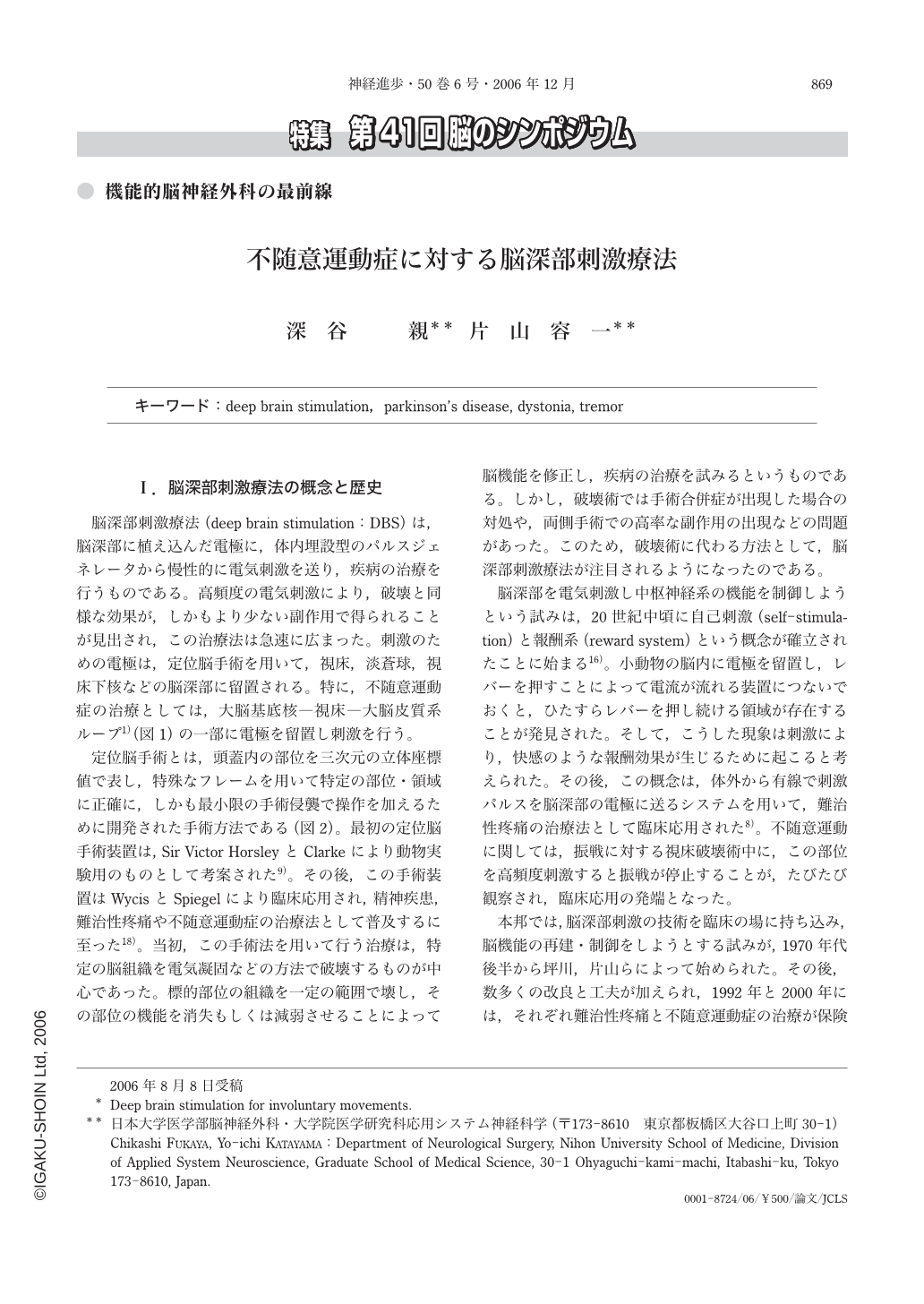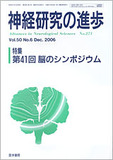Japanese
English
- 有料閲覧
- Abstract 文献概要
- 1ページ目 Look Inside
- 参考文献 Reference
Ⅰ.脳深部刺激療法の概念と歴史
脳深部刺激療法(deep brain stimulation:DBS)は,脳深部に植え込んだ電極に,体内埋設型のパルスジェネレータから慢性的に電気刺激を送り,疾病の治療を行うものである。高頻度の電気刺激により,破壊と同様な効果が,しかもより少ない副作用で得られることが見出され,この治療法は急速に広まった。刺激のための電極は,定位脳手術を用いて,視床,淡蒼球,視床下核などの脳深部に留置される。特に,不随意運動症の治療としては,大脳基底核―視床―大脳皮質系ループ1)(図1)の一部に電極を留置し刺激を行う。
定位脳手術とは,頭蓋内の部位を三次元の立体座標値で表し,特殊なフレームを用いて特定の部位・領域に正確に,しかも最小限の手術侵襲で操作を加えるために開発された手術方法である(図2)。最初の定位脳手術装置は,Sir Victor HorsleyとClarkeにより動物実験用のものとして考案された9)。その後,この手術装置はWycisとSpiegelにより臨床応用され,精神疾患,難治性疼痛や不随意運動症の治療法として普及するに至った18)。当初,この手術法を用いて行う治療は,特定の脳組織を電気凝固などの方法で破壊するものが中心であった。標的部位の組織を一定の範囲で壊し,その部位の機能を消失もしくは減弱させることによって脳機能を修正し,疾病の治療を試みるというものである。しかし,破壊術では手術合併症が出現した場合の対処や,両側手術での高率な副作用の出現などの問題があった。このため,破壊術に代わる方法として,脳深部刺激療法が注目されるようになったのである。
脳深部を電気刺激し中枢神経系の機能を制御しようという試みは,20世紀中頃に自己刺激(self-stimulation)と報酬系(reward system)という概念が確立されたことに始まる16)。小動物の脳内に電極を留置し,レバーを押すことによって電流が流れる装置につないでおくと,ひたすらレバーを押し続ける領域が存在することが発見された。そして,こうした現象は刺激により,快感のような報酬効果が生じるために起こると考えられた。その後,この概念は,体外から有線で刺激パルスを脳深部の電極に送るシステムを用いて,難治性疼痛の治療法として臨床応用された8)。不随意運動に関しては,振戦に対する視床破壊術中に,この部位を高頻度刺激すると振戦が停止することが,たびたび観察され,臨床応用の発端となった。
本邦では,脳深部刺激の技術を臨床の場に持ち込み,脳機能の再建・制御をしようとする試みが,1970年代後半から坪川,片山らによって始められた。その後,数多くの改良と工夫が加えられ,1992年と2000年には,それぞれ難治性疼痛と不随意運動症の治療が保険適用となった。
In an attempt to control hypokinetic and hyperkinetic movement disorders, deep brain stimulation(DBS)has been developed during the last two decades by several investigators. In 1987, Benabid and his colleagues suggested the usefulness of high-frequency stimulation of the ventral intermediate nucleus of the thalamus for treating drug-resistant tremors and avoiding the adverse effects of thalamotomy. Since then, DBS has been used as an alternative to lesions in functional neurosurgery of movement disorder, and more recently, it has been applied to the treatment of epilepsy, obsessive-compulsive disorders, and cluster headache, and it has other applications in experimental models.
Regarding the treatment of movement disorders, results of recent clinical studies have demonstrated that DBS affords great benefits regarding daily activities of patients with Parkinson's disease(PD), essential tremor, dystonia, and poststroke hyperkinetic movement disorders. We have treated patients with movement disorders by DBS of the thalamic nuclei ventralis oralis(Voa/Vop)et intermedius(Vim),globus pallidus internus(GPi), and subthalamic nucleus(STN). The site of permanent electrode placement was identified using magnetic resonance imaging and multiunit extracellular recording. The implantable pulse generator was internalized after postoperative test stimulation for one week. The stimulation parameters were modified by physicians at each follow-up visit on the basis of neurological examination findings, as well as the patient's report concerning activities of daily living.
The advantages of DBS include reversibility and controllability of stimulation. In addition, DBS carries a smaller risk of side effects, particularly when employed bilaterally. Thalamic DBS is useful for controlling tremor that is unresponsive to medication. DBS of the STN and the GPi improves the motor function of PD patients mainly during the off-period. Moreover, STN-DBS attenuates levodopa-induced dyskinesia through the reduction of dopa requirement, whereas GPi-DBS directly attenuates dopa-induced dyskinesia. In addition, GPi-DBS is very useful for controlling symptoms of idiopatic generalized dystonia. According to some reports, there were few serious adverse effects associated with DBS. Generally, the operative mortality is less than 1%. The incidences of hemorrhage are in the range of about 1-6%, and the incidences of device-related complications, such as infection or skin erosion, are in the range of 3-26%. DBS is clinically effective in well-selected patients and should be considered as a treatment option for patients with medically refractory movement disorders.
Despite its clinical usefulness, the mechanism of efficacy is still unclear. There is no current proof that long-term DBS is able to reset neural networks, or to induce profound modifications of functional organization. Several researchers proposed hypotheses concerning the mechanism underlying the efficacy of DBS, which might involve the following 1)jamming of neural transmission, 2)direct inhibition of spike initiation at the level of the membrane that may be due to the activation of inhibitory terminals, 3)functional changes due to a decrease or an increase in the amount of neurotransmitter released, and 4)retrograde activation of upstream neural structures. From the viewpoint of basic neuroscience, the development of DBS is intriguing. Investigation regarding the mechanism underlying the efficacy of DBS may provide us a clue that may further clarify various processes in central nervous system.

Copyright © 2006, Igaku-Shoin Ltd. All rights reserved.


